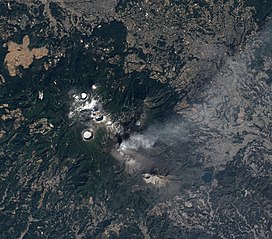This article needs additional citations for
verification. (August 2019) |
| Kirishima Mountains | |
|---|---|
 Kirishima Volcano Groups | |
| Highest point | |
| Peak | Karakuni-dake |
| Elevation | 1,700 m (5,600 ft) |
| Coordinates | 31°56′17″N 130°51′41″E / 31.93806°N 130.86139°E |
| Geography | |
| Country | Japan |
| Prefectures | Kagoshima prefecture and Miyazaki prefecture |


Kirishima Mountains (霧島山, Kirishima-yama) are a 1700 meter high active volcano group in Kagoshima Prefecture and Miyazaki Prefecture, Kyushu, Japan. Numerous eruptions have been recorded since 742. Very strong eruptions happened in 788, 1716 and 1717.[ citation needed] Augite- hypersthene andesite is the dominant rock type. [1]
The highest peak is Karakuni-dake (韓国岳, Karakunidake) (1700 m). Its name literally means "Korea Peak"; it was once believed to be so high that the Korean Peninsula could be seen from its summit. Other peaks include the sacred and often fabled in national foundation mythology, Takachiho-no-mine (高千穂峰) (1573 m) as well as Shinmoedake (新燃岳), both active volcanoes. They are part of Kirishima-Yaku National Park near Kirishima City. Legend via oldest extant texts state the summit of Takachiho was stuck the mysterious spear Ama-no-Sakahoko, by the legendary Ninigi-no-Mikoto. Mount Kirishima is considered one of the 100 Famous Japanese Mountains. The area is often foggy, and it is believed that the name Kirishima comes from the mountain looking like an island in the fog.
The Kongō-class battlecruiser Kirishima of the Imperial Japanese Navy, and the Kongō-class guided missile destroyer Kirishima of the Japan Maritime Self-Defense Force were both named after this mountain.
Shinmoedake is the most active of the Mount Kirishima volcanoes, having erupted in January 2011, March 2011, October 2017, [2] and April 2018. [3]
The region as well as areas downstream is in the path of expanding Meiyu front from the continent, during the East Asian rainy season, potentially unleashing flash flooding and landslides during this time.
- Kirishima Volcano Group
-
Takachihonomine Volcano
-
Kirishima Volcano Group
-
Shinmoedake Volcano (front) & Takachihonomine Volcano
-
Ohachi Volcano
-
Rokkan'nonmiike Volcano (front) & Koshikidake Volcano (background)
-
Onamiike Volcano
-
Karakunidake Volcano
-
Hudouike Volcano
-
Hinamoridake Volcano
-
Kurinodake Volcano
See also
References
- ^ "Mt. Kirishima". Archived from the original on 2011-01-30. Retrieved 2011-01-31.
- ^ "Kyushu's Shinmoedake volcano erupts for first time in six years".
- ^ "硫黄山、約250年ぶり噴火 ケガ人なし". Archived from the original on 2018-04-20. Retrieved 2018-04-20.
External links
- Kirishimayama - Japan Meteorological Agency (in Japanese)
- "Kirishimayama: National catalogue of the active volcanoes in Japan" (PDF). - Japan Meteorological Agency
- Kirishima Volcano - Geological Survey of Japan
- "Kirishimayama". Global Volcanism Program. Smithsonian Institution. Retrieved 2021-06-24.
- Kirishima Geopark - The Kirishima Geopark Council









